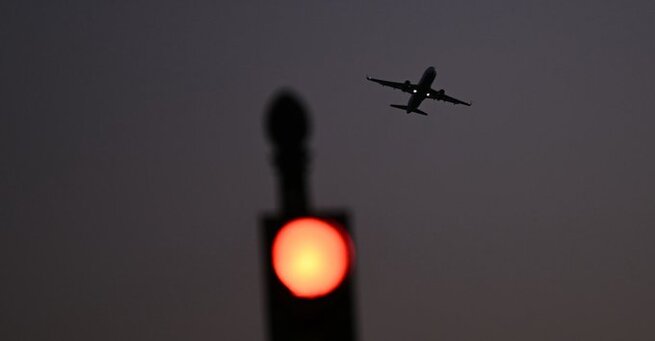Alerts

The government shutdown is strangling aviation across the United States, and the effects are being felt by travelers, airport workers, and airlines alike. Since October 1st, when the shutdown began over a federal budget dispute, America’s aviation system has been thrown into chaos — just as experts warned it would.
More than 6,000 flights are delayed daily, nearly twice the normal rate for this time of year, according to the Department of Transportation. Security lines are getting longer as the TSA halts real-time checkpoint updates in its MyTSA app. Some airports have even gone hours without air traffic control, forcing flight crews and passengers to navigate uncertainty in the skies and on the ground.
Earlier this year, aviation analysts warned that the U.S. system was fragile — one small disruption could cause nationwide breakdowns. That disruption arrived when the government ran out of funding on October 1st.
The immediate impact was severe. Over 500,000 federal employees were furloughed without pay, but 75,000 air traffic controllers and TSA officers were deemed “essential,” meaning they must still work — even if their paychecks are delayed indefinitely.
This arrangement has placed a massive strain on workers already stretched thin. Many can’t afford to keep showing up without pay, and their absence compounds an already critical staffing shortage.
Transportation Secretary Sean Duffy tried to calm fears on X (formerly Twitter), saying:
“Controllers who show up to work will get paid — just not on time.”
But for many workers, that reassurance rings hollow. Johnny Jones, a veteran TSA officer and union representative with the American Federation of Government Employees, told The Verge that morale is crumbling.
“Our number one problem is the uncertainty surrounding how long this is going to go on,” Jones said. “You’re being asked to come to work without pay — indefinitely.”
The longer the standoff continues, the greater the risk to safety, efficiency, and national confidence in the aviation system.
The government shutdown is strangling aviation not only because of unpaid workers but also because it disrupts every layer of airport operations. When critical staff are distracted by financial stress or forced to quit, the domino effect reaches flight schedules, passenger experience, and even emergency response readiness.
Air traffic controllers manage thousands of planes daily. Any gaps in their ranks mean slower takeoffs, grounded flights, and potential safety concerns. Meanwhile, TSA checkpoints are bottlenecked as fewer officers report to work, leaving travelers frustrated and airlines dealing with costly delays.
Reports have surfaced of major U.S. airports operating without full air traffic control for hours at a time — a dangerous and unprecedented situation. While backup systems and coordination efforts are in place, experts warn that even brief lapses can have long-term consequences for safety and scheduling.
These gaps strain pilots, increase stress on remaining staff, and heighten the risk of communication errors. For an industry where precision and coordination are vital, even minor disruptions ripple across the entire network.
Beyond inconvenience, the financial losses are mounting. Airlines lose millions daily from delays, rebookings, and reduced passenger confidence. Airports dependent on federal grants and maintenance funding are delaying crucial projects.
Travelers, too, are paying the price — both literally and figuratively. Ticket prices may climb as airlines attempt to offset losses, and travelers face unpredictable wait times at security checkpoints.
The ripple effect extends to the broader economy, from hospitality to logistics, as goods and people move slower through the nation’s air corridors.
The shutdown stems from a familiar source — a congressional stalemate over spending priorities. Yet this time, the aviation sector has become one of its most visible casualties.
As lawmakers debate over budgetary details, airports are turning into case studies of political gridlock’s human cost. Workers are calling out sick, airlines are scrambling to maintain schedules, and passengers are left stranded in terminals that once symbolized national efficiency.
At Reagan National Airport in Arlington, Virginia — just miles from the Capitol — travelers describe scenes of mounting frustration.
“I’ve missed two connections already,” said frequent flyer Amanda Lee. “Everyone’s trying their best, but you can feel how stretched the system is.”
Union leaders warn that morale among unpaid aviation employees is dangerously low. Some are resorting to food banks, while others are seeking temporary work outside the industry.
Aviation experts say that even after the shutdown ends, recovery could take weeks. Systems will need recalibration, scheduling backlogs will persist, and some experienced workers may never return.
The government shutdown is strangling aviation not just for now — but for the foreseeable future. Every day it continues, the cracks in the system deepen.
The crisis is a stark reminder of how interdependent America’s infrastructure truly is. When federal funding stops, the effects cascade — from the tarmac to the tower, from baggage belts to boarding gates.
If aviation is to remain reliable and safe, experts urge Congress to establish stronger safeguards for essential operations during budget impasses. Until then, travelers and workers alike will continue navigating uncertainty at 30,000 feet.
𝗦𝗲𝗺𝗮𝘀𝗼𝗰𝗶𝗮𝗹 𝗶𝘀 𝘄𝗵𝗲𝗿𝗲 𝗿𝗲𝗮𝗹 𝗽𝗲𝗼𝗽𝗹𝗲 𝗰𝗼𝗻𝗻𝗲𝗰𝘁, 𝗴𝗿𝗼𝘄, 𝗮𝗻𝗱 𝗯𝗲𝗹𝗼𝗻𝗴. We’re more than just a social platform — from jobs and blogs to events and daily chats, we bring people and ideas together in one simple, meaningful space.